HMG 3400 southwest review
Ah, the beloved Hyperlite Mountain Gear 3400 Southwest. Fed up with my old pack, (an old REI Flash) I bought this baby for the JMT in 2019 (at REI, ironically enough) and haven't looked back. It's one of my favorite gear purchases to date.
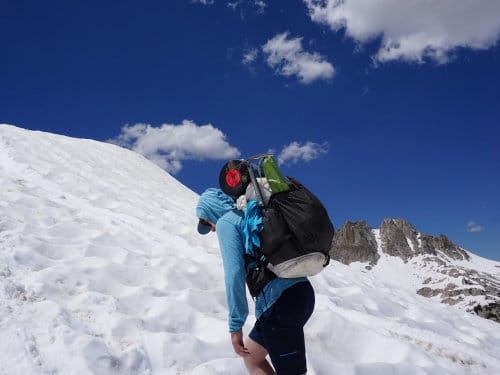
One of a large series (including the Southwest, Windrider, and Junction 2400, 3400, and 4400), these packs in general have become synonymous with the spirit of thru-hiking. They're simple, ultralight, and ultra-durable, doing everything you need them to and nothing you don't. I absolutely love this pack, but that doesn't necessarily mean they're right for everyone and I'll get into the details of that in this review.
This post may contain affiliate links. If you decide to make a purchase through the links on this site then we may get a commission at no extra cost to you. These purchases support the site and allow us to continue to provide great content 🙂
Tech Specs
- Capacity: 55L (or 3400 cubic inches, hence the name) +9.8L external storage
- Weight: 32.11 oz (White) / 34.97 oz (Black)
- Load Capacity: Up to 40 lbs (30 pounds comfortably)
- Materials: Dyneema Composite Hybrid 50 (White) / Dyneema Composite Hybrid 150 (Black) - (the bottom is DCH150 in both colors)
- Frame/Suspension: Internal aluminum stays
- Pockets: 3 external "Hardline with Dyneema"
- Made in: Maine, USA
- MSRP: $355 USD (never on sale, but I used my annual 20% REI member coupon when I bought mine; link to the Southwest at REI here)
I'll note here for those that are new to the HMG pack system and terminology that this is one of a series of very similar packs. The 3400 refers to the capacity being 3400 cubic inches (55L). These packs are also made in a 2400 (40L) and a 4400 (70L) version. The 2400 has the same opening and body diameter, with all the extra capacity added vertically in a longer collar. The 4400 is both wider and longer, making it ideal for bulkier gear.
The 'Southwest' refers to the external pockets; they are made of solid 'Hardline with Dyneema' material which is heavier but very abrasion resistant.
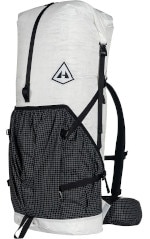
The 'Windrider' is an identical pack, but the external pockets are made of mesh, which is lighter but less durable.
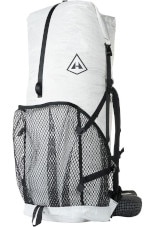
*Last year HMG came out with the Junction, which has the same body as the Windrider and Southwest, but the rear pocket is mesh and the side pockets are solid. Most damaging abrasion happens on the sides of a pack, so this is the best of both worlds. I'll say right now that it's what I would have gone with if it had existed when I bought mine. But alas, the Southwest will have to do for now (and probably forever).*
Key Features
This pack is about as no-frills as any I've used. There aren't a ton of "features" to speak of, but I'll go over how this pack is set up.
- One large main compartment with roll-top closure
- Buckles on both sides of the roll top that connect to side straps for vertical compression
- Y-strap that goes over the top for compression or outer storage
- Side straps for horizontal compression
- 3 external solid pockets with elastic (1 on each side and 1 on the back)
- Internal contoured aluminum stays
- 3/8" closed cell foam shoulder straps and hip belt
- Spacious hip belt pockets (updated, much better than older versions)
- Internal hydration sleeve and hydration port
- Ice axe loop
Layout
This is a classic ultralight pack. There is one main compartment with a dry-bag style roll top closure. When rolled down, you can clip the top to vertical straps on the sides and compress it down tight. There is a Y-strap on top that can be used to create more even compression or store more gear (like a bear can or Z-lite sleeping pad).
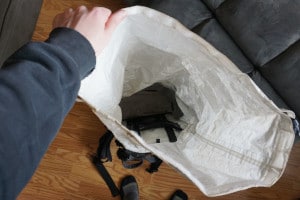
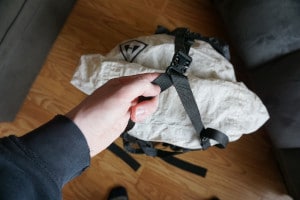
The three outer pockets on the Southwest are made of solid Dyneema Hardline which is ultra durable and also water resistant. These pockets are actually pretty spacious and there's plenty of room for anything you need access to on the outside. I don't usually use side pockets for water bottles, but I did test it for those who do and I could easily grab and replace a smartwater bottle without taking off or adjusting the pack. For a lot of people that's a big plus.
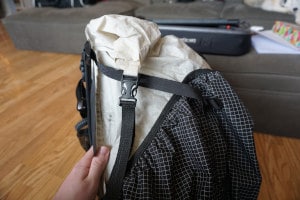
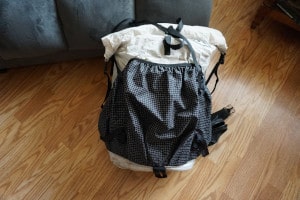
Suspension
This being a minimalist pack, it doesn't have a frame. It uses two aluminum "frame stays" which go into slots in the interior that secure at the bottom to the hip belt. They come "contoured," but the idea is that you can bend them to fit you however you want. This system actually works great for being so minimal. The hip belt straps have a particularly solid connection to the back piece so it can carry more weight comfortably than you might think (up to about 30 lbs).
My only issue with the suspension is the lack of load lifters. I know it's supposed to be minimalist, but since the extra space in the 3400 is added vertically it would make sense to have a way to pull the extra height down and forward. Without them that extra space isn't nearly as useful as it could be.
Other stuff
There's not much other stuff to talk about with this pack, but one little thing I find especially useful is the daisy chained shoulder straps. These allow you to easily add all types of accessories. I use them for a water bottle pocket and a camera clip.
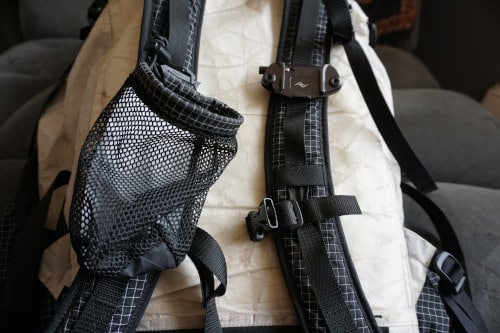
Highlights
Durability
I've used this pack for hundreds of miles now and have yet to see even the slightest sign of wear. I'll let you know if I ever have an issue I feel is worth mentioning, but for now it's living up to it's reputation as one of the most durable packs out there (maybe ever).
Waterproofness
This is one of my favorite things about this pack. It's not submersible (due to the drain hole at the bottom), but for regular backpacking purposes this pack is as waterproof as you'll ever need it to be. It's an amazing feeling when it starts pouring and you don't have to scramble to throw a pack cover on (that barely works anyway) or worry that you didn't quite seal your pack liner.
The hip belt
I love the hip belt on this thing. The weight transfer is perfect and I've never noticed any pinch points or scratching. It's one of those things where you don't even notice how comfortable it is until you put on a different pack and go, "How did I ever wear this?". This hip belt really is about as good as it gets and will keep you going through many extra long days.
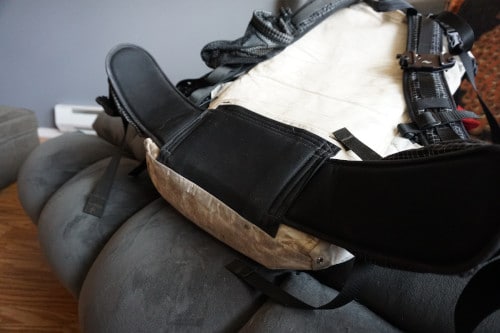
Lowlights
Weight Capacity
Maybe it's just me, but I don't feel like "up to 40 pounds comfortably" is really accurate. I think for true all day comfort it maxes out at about 30lbs. This isn't so much a fault of the pack as it is of marketing, because I don't think packs this ultralight should ever be expected to carry that much weight comfortably (with todays materials, at least).
I will say it carries heavier loads better than the average ultralight pack, so it's a good option if you'll occasionally need to haul extra weight. But if you're planning on exceeding 30lbs regularly you really need something a little beefier (The Osprey Atmos AG 65 is a great option).
The Price
There's no way around the fact that $345 is a steep price for any piece of gear. This kind of price just comes with the DCF territory (which I think for big 4 gear pieces is very often worth it), but it can be hard to justify for many.
I noted above but I'll say it here too; these packs are now sold by REI (affiliate link to the Southwest here), and you can use your annual 20% off member coupon on them. That's $70 off, more than offsetting the $20 membership fee if you're not already a member (member coupons get sent out in March, May, and November). And if you are a member and you already used your coupon, you should still buy from REI and snag that 10% "member dividend".
Recommendation
I highly recommend this pack for anyone looking to go really light. Pulling it out of the box you'll be amazed at how light it feels in your hand compared to more traditional pack, and that translates directly to on-trail comfort. Plus, though expensive, the DCF is ultra-light as well as ultra-durable, and its waterproofness simplifies and lightens your set-up.
I personally like the 3400, because for just a little extra weight (as compared to the 2400) it's quite a bit more versatile in terms of how much you can bring. Like I said above, it won't be as comfortable, but if your average pack weight is below 30lbs and you're only exceeding that occasionally, it's no big deal. If you already have a heavy-load pack you love and want to go as minimal as possible, get the 2400 (and consider the Windrider or the Junction).
HMG packs are now available at REI, so you can use your seasonal coupons or earn REI dividends if you're a member and get a nice discount on an expensive pack. You can buy the Southwest 3400 here, or Southwest 2400 here.
That's it! I'd love to hear about your experiences with this pack or answer any questions you might have in the comments.

If you’re going to write an article you should probably do a little research and get the info correct. The difference between the 2400 and 3400 is the height of the collar (main bag)..All models of the 4400 are not only taller but the pack its self is wider. Basic info is not hard to find..
I spend a lot of time researching and testing for these articles and strive to get all my information correct, but sometimes mistakes happen. Appreciate the correction, and I’ve fixed it in the post.
This is super helpful, thanks Brady! I’ve been debating over a few different packs (HMG Southwest/Junction, GG Mariposa, ULA Circuit) lately as my wife and I both transition from Gregory Baltoro 75 (me) and Osprey Ariel 65 (her) into UL packs. We didn’t know much about lightweight backpacking when we started and are now looking at ways to cut our weight down. I know the HMG packs are a bit light on features, how do you feel like that would be as a transition from a full feature pack?
It’s definitely an adjustment. I used an REI pack for a long time that had tons of zippered compartments and a top lid, and it took some getting used to when I got my HMG. I’ve had to learn how to pack smarter, and I use pods/cubes now (often with several ziplocs inside those) to help with organization since my pack no longer does it for me. I find now that I prefer it that way, as it forces me to think about the things I take and where they go, and I ultimately end up with less unused stuff.